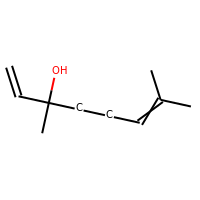
Linalool
| Chemical identification | |
|---|---|
| Pubchem identifier | 6549 |
| CAS identifier | 78-70-6 |
| DSSTOX identifier | DTXSID7025502 |
| IUPAC name | Linalool |
| SMILES | CC(=CCCC(C)(C=C)O)C |
| InChI | InChI=1S/C10H18O/c1-5-10(4,11)8-6-7-9(2)3/h5,7,11H,1,6,8H2,2-4H3 |
| InChIKey | CDOSHBSSFJOMGT-UHFFFAOYSA-N |
| Synonyms | 2,6-Dimethyl-2,7-octadiene-6-ol; Allo-ocimenol; 1,6-Octadien-3-ol, 3,7-dimethyl-; 2,6-Dimethyl-2,7-octadien-6-ol; (1)-3,7-Dimethyl-1,6-octadien-3-ol; 2,7-Octadien-6-ol, 2,6-dimethyl-; p-Lilool; beta-Lilool; Lilool; Lilyl alcohol; (+-)-Lilool; 3,7-Dimethyl-1,6-octadien-3-ol; 3,7-Dimethylocta-1,6-dien-3-ol; 2,6-Dimethylocta-2,7-dien-6-ol |
| Odor profile | |
|---|---|
| Odor classes | Aromatic, Citrus, Edible oil, Floral, Sweet spices, Tropical, Vegetable |
| Reference | [1] |
| Presence in Children's products | |
|---|---|
| Broad category | Diapering, Hair care, Miscellaneous, Skin care, Toys |
| Subcategory | Baby Wipes, Baby Shampoo And Shower Gel, General Baby products, Baby Gel, Baby Moisturizing Cream and Lotion, Clay Toys, Plush Toys, Scented Toys |
| Chemical classification based on ClassyFire | |
|---|---|
| Chemical kingdom | Organic compounds |
| Chemical super-class | Lipids and lipid-like molecules |
| Chemical class | Prenol lipids |
| Chemical subclass | Monoterpenoids |
| Natural source for the chemical | |||
|---|---|---|---|
| Organism | Kingdom | Genus | Family |
| Anacardium occidentale | Plantae | Anacardium | Anacardiaceae |
| Acorus calanus L. | Plantae | Acorus | Acoraceae |
| Actinidia arguta | Plantae | Actinidia | Actinidiaceae |
| Coriandrum sativum | Plantae | Coriandrum | Apiaceae |
| Ocimum basilicum | Plantae | Ocimum | Labiatae |
| Reference | [1], [2], [3], [4] | ||